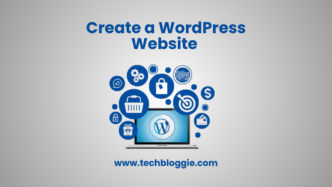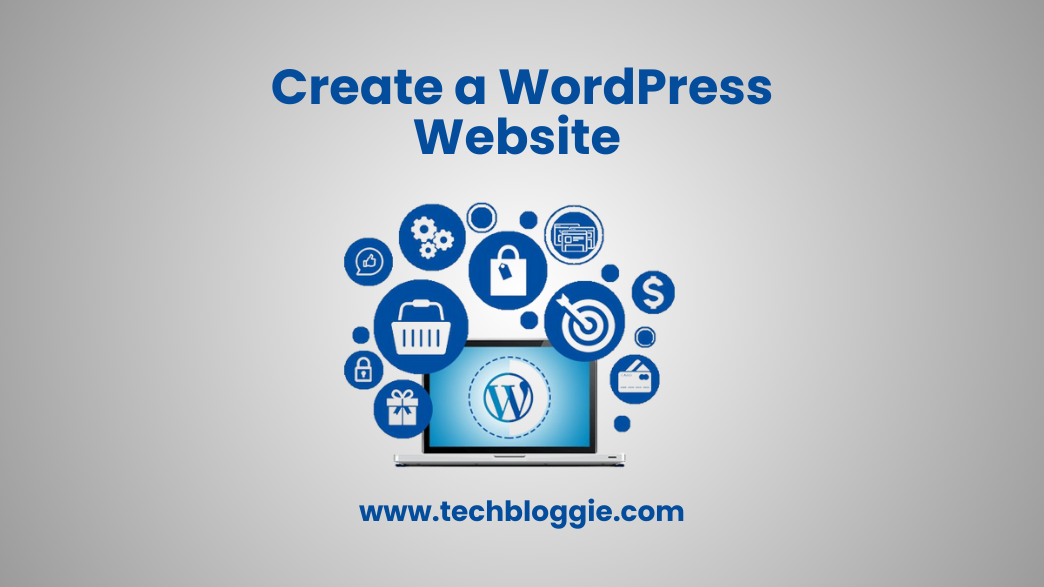Digital presence with WordPress that not only promotes your business but also efficiently engages and captivates your audience thanks to its wide selection of plugins, themes, and user-friendly interface.
Its popularity is due to its versatility in meeting the needs of e-commerce platforms, blogs, portfolios, and corporate websites. So whether you’re a budding entrepreneur or a seasoned business owner, WordPress is the platform of choice for creating a polished and dynamic online presence that makes an impact.
Install WordPress

Install WordPress (or, more specifically, link your web hosting service to WordPress) when you’ve finished making your purchase of a web hosting plan, such as one from our preferred company, Dream Host.
To do this, go to your user dashboard (or cPanel), select “Websites” from the left-hand vertical menu, and then click “Manage Websites.” Next, locate the website you want to create, select it, click “Manage,” and then select “Install WordPress.”
Get a domain name and web hosting
Web hosting is required for a website. It is a free website builder, but for your site to be visible online, you must use a web hosting service. The average cost of web hosting is less than $10 per month, and by buying hosting first, you’ll save time and money because the best hosting plans include one-click WordPress installation and a free domain name, making setting up a website much easier.
Select a domain name
If you select a web hosting package from a company like Dream Host that includes a free domain name (like businessname.com), you will be required to select a domain during the account registration process. If not, buy a domain name directly from one of the top registrars, like GoDaddy or Google Domains, and manually link it to your web hosting provider.
Consider the following while selecting a domain name:
- The shorter, the better.
- Avoid numbers and dashes.
- Avoid using trademarked names and copyrighted material.
- Make sure the domain is available.
Choose your theme
Using one of the many WordPress themes or templates, you can change the layout, formatting, color scheme, font, and other visual elements of your website.
The WordPress automatically uses a rather dull default theme. Although you can keep it, website visitors may not be as impressed. No matter how much it costs, a customized theme will give your website and your buyer personas a friendly and professional look.
Install plugins
Plugins serve as additions to your WordPress website, giving you the chance to improve its functionality and adapt it to your own requirements. These extensions may include integrating photo galleries, adding contact forms, and many other features. It’s simple to install plugins: just go to your WordPress dashboard, find the Plugins page, and then install the plugins you want.
Over 59,000 free plugins are available in the WordPress ecosystem, and third-party websites and developers also provide paid plugins for customers looking for even more specific features and capabilities.
Features
Using WP Forms Lite, You can include a contact form on your WordPress website. Every professional website has a contact form and contact information on the same page. Without any further setup, you can even accept payments with WP Forms Lite.
Using MonsterInsights: Monitor how users locate and interact with your website so you can entice them to return.
SeedProd: A drag-and-drop page builder that allows anyone, regardless of technical ability, to create fully unique designs and layouts.
Establish Crucial Site Settings

Setting up permalinks is crucial for your WordPress website. They determine how your links look and represent your site’s structure. A well-structured permalink helps visitors navigate your site effectively. To set your permalink structure, go to Settings > Permalinks in your WordPress dashboard.
- Logo: Go to “Appearance” > “customize” > “site identity > “change logo and upload your logo
- Site title: Go to “Appearance” > “customise” > “site identity > input site title (a.k.a. your business name)
- Site tagline: Enter the site tagline by selecting “appearance” > “customize” > “site identity” (or just remove the default WordPress tagline).
- Site icon: Go to “Appearance” > “customize” > “site identity > under “site icon,” click “change image” > upload the image you want to display as your site icon (a.k.a. favicon).
- Homepage: Go to “Appearance” > “Customize” > “Homepage settings” and select the webpage you want to set as your homepage.
- Blog: Go to “Appearance” > “Customize” > “homepage setting,” and under the post page, select the page you want to set as your blog.
- Permalink settings: Go to “settings” >“permalink,” then choose your preferred structure (typically “post name”) and save changes.
On your WordPress website, add posts and pages
For blogs and portfolios, posts (or “dynamic pages”) are frequently utilized since they automatically display the most recent website content at the top of your featured content.
Pages are more enticing to business owners because they are static and the updated content remains in the same place.
In WordPress, the two most common post types are posts and pages. There are new post types as well as more native post types available. At this moment, only pages and posts will do.
Selecting a post or page to act as your website’s homepage (or any other page) should be your first choice. By heading to the admin dashboard, selecting content, and then selecting Add New, you can add content to your website.
Set Up Your Menu
Create and customize your menu after setting up your pages. Following your theme, you might have more than one menu (for example, one at the top of the page and one at the bottom) because this is how people move across your website.
- To set up your site menu, follow these instructions:
- Using your dashboard, select “appearance” > “menus.”
- Select the page from the list on the left to add it.
- To reorder your menu or nest pages underneath one another as subpages, click and hold on the pages you want to change.
- To save changes, click.
When you have finished setting up your menu, scroll down to the “menu settings” portion of the same page. The box next to “primary” under “display location” should be checked. The menu will then be configured as the primary menu for your website, appearing in the header.
Market Your Site

The reason is that websites aren’t always a case of “build it and they will come.” Instead, companies that succeed online are those that have made investments in a range of internet marketing techniques to increase their site’s visibility online, which will help draw traffic to their website.
Some of the best strategies for promoting your website are listed below:
- To help your URL rank more rapidly, submit it to Google Search Console.
- A Facebook Business Page, an Instagram account, or a Pinterest business account are a few examples of social media profiles you should create for your website and link to in your postings.
- Include relevant internet directories on your website, such as Yelp, TripAdvisor, and the Yellow Pages.
- To appear in local searches, register for a Google My Business account.
- Join the Better Business Bureau with your company.
- Include the URL of your website in your email signature, business cards, and any other items you use for promotion.
WordPress Advantages
The most widely used blogging platform is WordPress on the internet, with over 43% of users. It is well-liked for a reason. With a lot of flexibility and customization choices, it is used to build websites, blogs, intricate portals, business websites, and applications.
A programmer’s paradise, the WordPress.org software is free and open-source. It is also supported by a sizable user and developer community that consistently produces fresh plugins, widgets, themes, and other goodies to improve the user experience.
Conclusion
A domain, a content management system, and a reliable web host like Hostinger are ultimately all you need to establish your WordPress website. You’ll rapidly amass a committed audience that frequents your website frequently if you keep experimenting and updating it.
FAQ’s
To create a WordPress website with a useful and appealing online presence, there are several tasks involved. The first step is to choose a domain name that accurately describes the function of your website and to order hosting from a reliable company. Following hosting configuration, installing WordPress is typically a simple procedure, frequently with one-click installations available.
What are the 8 steps on how to create your own blog using WordPress?
- Select a hosting package.
- Choose and secure a domain name.
- Activate WordPress.
- Log in to your WordPress administration dashboard.
- Decide on a blog title.
- Incorporate a logo and favicon.
- Your WordPress theme should be installed and customized.
- Add a background image and a header.
How can I, step-by-step, establish a WordPress website?
When your hosting and domain are all up, you can download and install WordPress, a well-liked free content management system that makes it easier to create and administer websites. For creating and managing the content on your website, WordPress offers a user-friendly platform.
What is the best way to create a WordPress website?
Website can be created in a variety of ways, but WordPress and website builders are the two that we found to be the simplest. If you’re a complete beginner, the best alternative for tech newbies is to construct your website using a tool like Wix, Squarespace, Shopify, or GoDaddy.
When building a WordPress website, what matters most?
Your website’s material should be clear, simple, and informative. More than anything else, well-written web copy and content will increase the appeal, effectiveness, and popularity of your website design. Unless your website design is web-friendly, it doesn’t matter how instructive, beautiful, or user-friendly it is.
Why is it important to create a WordPress website?
A website promotes your brand to potential clients and aids in creating brand awareness. You can create an image by letting the audience know who you are and what you stand for. Having a website helps your business stand out from the competition by providing users with reliable information.

